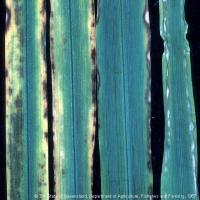Diagnosing magnesium deficiency in barley
Western Australia (WA) agricultural soils, particularly acidic sands, are inherently low in magnesium but deficiency is rare in broadacre crops.
What to look for
- Young plants have poor growth and pale yellow foliage.
- In more mature crops plants are stunted with thin spindly stems and pale yellow foliage marked with necrotic lesions.
- Linear, grey to dark brown dead lesions appear at or near the leaf margin, usually near the mid-section of the leaf. Lesions spread rapidly towards the tip and base of the leaf until the whole leaf becomes dark yellow with dark brown lesions throughout its length.
Plant
What else could it be
| Condition | Similarities | Differences |
|---|---|---|
| Diagnosing potassium deficiency in barley | Pale plants starting from the oldest leaves | Magnesium deficient plants have linear, grey to dark brown lesions at or near the leaf margin |
| Diagnosing nitrogen deficiency in barley | Pale plants starting from the oldest leaves | Magnesium deficient plants have linear, grey to dark brown lesions at or near the leaf margin |
| Diagnosing waterlogging in cereals | Pale plants starting from the oldest leaves | Magnesium deficient plants have linear, grey to dark brown lesions at or near the leaf margin |
Where does it occur?

Soil type
- Magnesium deficiency is more common in acidic sandy soils that have been amended with high rates of potassium or calcium in lime or gypsum that displaces magnesium from the exchange complex.
Management strategies
- No yield responses to magnesium presently justify soil application. However dolomite or magnesium fertiliser could be used if magnesium deficiency arose in WA.
How can it be monitored?

Tissue test
- Use whole-top plant test to diagnose suspected magnesium deficiency. A concentration greater than 0.12 % (guideline only) is adequate in whole shoots at the boot stage. No critical concentration is available for whole shoots for several growth stages.
- Take paired good/poor plant samples when possible.
- There is no locally calibrated soil test for magnesium.
- Topsoil calcium:magnesium ratios have little value as magnesium mostly increases with depth, with higher proportions of magnesium to calcium on exchange sites in subsoils.
See also
Further information
Where to go for expert help
Page last updated: Wednesday, 6 May 2015 - 1:41pm



